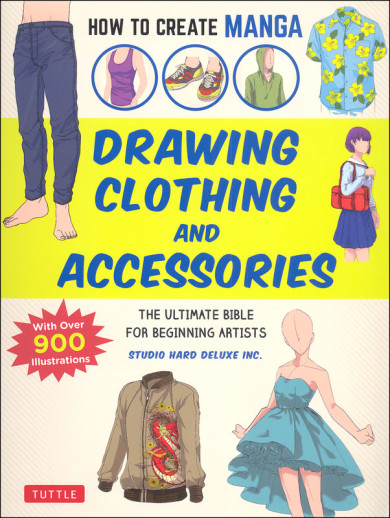We use cookies to make your experience better. To comply with the new e-Privacy directive, we need to ask for your consent to set the cookies. Learn more.
How to Create Manga Drawing Clothing and Accessories
As if drawing the human form wasn't hard enough, adding convincing clothing with all its drapes, creases, and shadows can make an artist crazy! This reference work demystifies that a bit, detailing types of clothing wrinkles and where they're likely to form when worn and pulled in certain directions. Having some idea of where to put shadows and folds makes it much easier to clothe your characters realistically. There's lots of variety here – all sorts of modern clothing styles from casual jeans and t-shirts to cute summer tops to formal wear to business suits are covered in this book, each presented with its structure in mind. There are also sections on shoes, bags, and other accessories, and prints and patterns are also discussed briefly. Best of all, there are Japanese-specific outfits included such as yukatas/kimonos, sailor suit uniforms, and boy's school uniforms. Although not a comprehensive guide to all clothing, there's enough meat here to use as a reference for most outfits you would want to draw. One notable exception is armor; sadly, there's no armor depicted in this book, and not much in the way of historical era clothes either. As alluded to earlier, this book is mostly a catalog of clothes with tips on how to draw them, and as such is best used as a reference. (Note: there is a section on how to draw undergarments and lingerie). 175 pgs, pb.
Have you ever struggled to get the drape of a dress or the look of a jacket just right? Maybe you've mastered the human form but your drawings lack a sense of fashion? Or perhaps you're a budding fashionista who loves decking your characters out in elegant, outrageous or cutting-edge outfits? No matter how you wish to clothe your creations, in traditional togs or casual fashions, How to Create Manga: Drawing Clothing and Accessories is the perfect tutorial for you!
Fashion meets form in this essential style guide to dressing up your drawings. Drape your manga creations in the wardrobe of your dreams, while learning techniques and tips used by professional illustrators to realistically draw clothing and accessories of all types—from blouses and T-shirts to button downs, sweaters, coats, pants, skirts and shorts. And what about the accessories? Boots, belts, shoes and sandals are all included as well, along with detailed coverage of satchels, purses and backpacks.
How to Create Manga: Drawing Clothing and Accessories is the fashion bible used by manga artists in Japan. It presents more than 900 drawings by twelve accomplished illustrators, covering a broad range of fashions. Detailed, in-depth instructionals show you how to render not just the garments themselves, but the folds, creases and wrinkles that give them a sense of realism and movement.
Other books in the series include How to Create Manga: Drawing Facial Expressions, How to Create Manga: Drawing the Human Body and How to Create Manga: Drawing Action Scenes and Characters.
| Product Format: | Paperback |
|---|---|
| Brand: | Tuttle Publishing |
| Grades: | 8-AD |
| ISBN: | 9784805315637 |
| Length in Inches: | 10 |
| Width in Inches: | 7.625 |
| Height in Inches: | 0.5625 |
| Weight in Pounds: | 1.55 |

